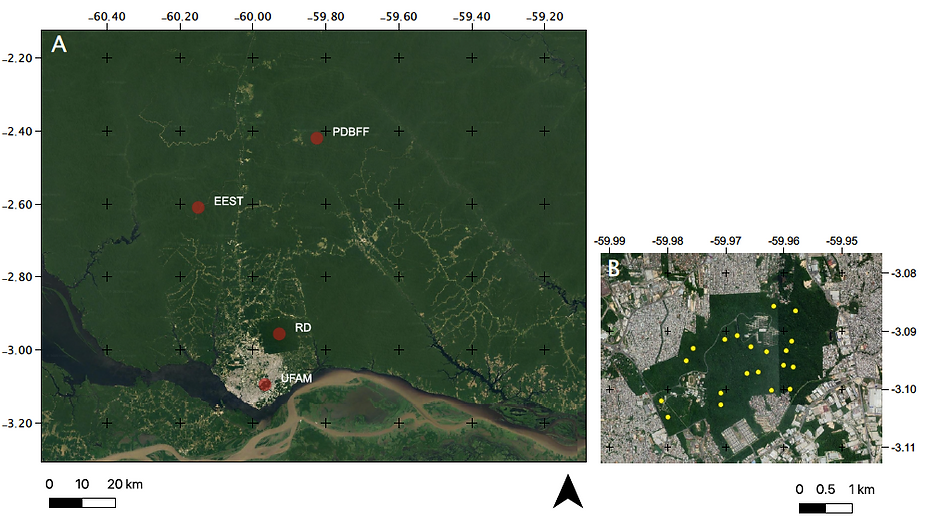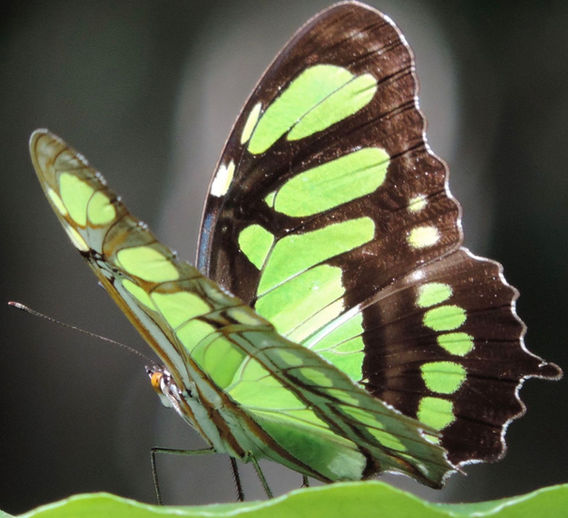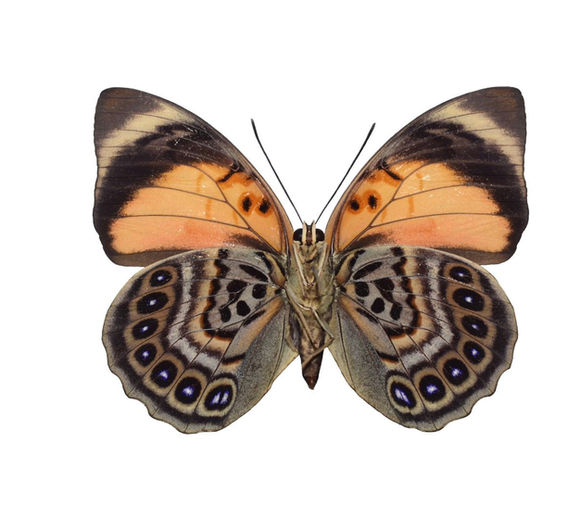Community Ecology Lab
Amazonia :: Brazil


Ongoing projects
Ant Functional Diversity of Brazilian Amazon Forests
We aim to create a large database about functional traits of ants in one of the most diverse forests on the planet: Amazon forests. We propose a collaborative research project involving researchers and students from different institutions to create, measure and test a set of functional traits. Using an extensive database of over 500 species of ants collected in 14 research sites, we aim to (1) develop and validate functional groups for soil ant fauna along a latitudinal gradient of 1800 km in the Brazilian Amazon basin; (2) demonstrate how ants functional traits are affected by environmental gradients; and (3) experimentally test the adaptive value of some functional traits.
This project is funded by CNPq (Universal 2014) and include the following researchers: Rogério Rosa da Silva - MPEG, Ricardo Solar - UFV, Jorge Luiz P. de Souza - INPA and Carlos André Nogueira - INPA

PPBio
The Brazilian Biodiversity Research Programme (PPBio) was created in 2004 to increase biodiversity studies in Brazil, decentralize the scientific production from academically developed centers, integrate research activities and disseminate the results for environmental management actions and education.
The Communities Ecology Lab contribute to the Local hub-Manaus coordinated by Prof. Marcelo Menin. Our main contribution in this project is to describe and understand the spatial distribution of ant's species and their respective parasitic fungi (Ophiocordyceps). But we also contribute to other research lines involving invertebrates, vertebrates and plants.

Ongoing projects
Amplifying ants: bioacoustics and music for environmental education
This interdisciplinary research group is formed by Lisa Schonberg, Anthony Brisson, Érica Marinho do Vale, Tainara Sobroza, Paulo Bobrowieck, and Fabricio Baccaro. The group is focused on two main lines: (1) scientific research on sounds produced by ants and (2) scientific dissemination to the general public through music and lectures. The general objective of the group is to produce quality scientific knowledge to be used directly for environmental education and dissemination. After many tests and adaptations, the group developed a protocol for recording the sounds produced by ants. These sounds are generally low frequency, but some species of ants use high frequency to communicate. Low-frequency sounds require equipment that picks up substrate vibration. The result is a sound reminiscent of the well-rhythmic communication of marine organisms that matches perfectly with the percussion compositions created by Lisa.

by Anthony Brisson during Ecology Field Course 2019 at RDS Rio Negro, Amazonas
PELD IAFA - Impactos Antrópicos na Floresta Amazônica
Established in 1998, the LTER-IAFA (Anthropogenic impacts in the Amazon Forest) is one of Brazil's oldest long-term research sites. Located in the Central Amazon around Manaus, LTER-IAFA has contributed to a better understanding of the interaction between temporal dynamics and environmental variation in space, as well as the potential synergistic effects of climate change and local anthropogenic disturbances on biological assemblages. These results have been summarized in three syntheses papers (Luizão et al. 2013, Costa et al. 2015, and Costa et al. 2020). At the end of 2020, LTER-IAFA gained financial support for the next four years. In this new phase, in addition to maintaining the monitoring of focal taxons (ants, birds, fish, lianas, palms, trees, and entomopathogenic fungi), the main goal is to increase the integration of research actions with society and biodiversity users. To this end, the campus of the Federal University of Amazonas (UFAM campus) has been included as a new long-term research area (Fig. below). The UFAM Campus is one of the largest urban fragments of tropical forest in the world. Its surroundings are densely occupied by people who interact very little with the local biodiversity. Despite being a forest fragment immersed in a populated urban region of more than 2 million inhabitants, many forest specialist species persist. One of the objectives of LTER-IAFA in this new phase is to support existing urban collectives (https://www.facebook.com/pg/caxxyri/posts/) to expand and document social knowledge about biodiversity and its use.
Besides the general project coordination, our main contribution to this project is to understand the dynamics of ant infection by fungal Ophiocordyceps parasites and the temporal dynamics of ant communities (but other research projects involving temporal dynamics are welcome).

(A) Location of the four LTER-IAFA areas in Central Amazon along a gradient of anthropic disturbance and (B) detail of the UFAM Campus, located at the end of the gradient immersed in the city of Manaus, Brazil. The yellow dots represent the permanent research plots already in place. PDBFF (Biological Dynamics of Forest Fragments Project), EEST (Estação Ecologia de Silvicultura Tropical), RD (Reserva Ducke).
We are proud to support and be part of
Synergize
Synergize (SYNthesising Ecological Responses to deGradation In amaZonian Environments) is a project of CNPq's Center for Synthesis in Biodiversity and Ecosystem Services - SinBiose - that aims to address knowledge gaps on biodiversity responses to ecosystem degradation. Its objective is to synthesize knowledge about biodiversity throughout the Brazilian Amazon and to understand the degree of integrity and threat to Amazonian forests, rivers, and streams.
We are proud to be part of this initiative and contribute to establishing a comprehensive ecological database of Amazonian biodiversity (among other cool information).


PPBio
The Brazilian Biodiversity Research Programme (PPBio) was created in 2004 to increase biodiversity studies in Brazil, decentralize the scientific production from academically developed centers, integrate research activities, and disseminate the results for environmental management actions and education.
The Community Ecology Lab contributes to the Local hub-Manaus. Our main contribution to this project is to describe and understand the spatial distribution of ant species and their respective parasitic fungi (Ophiocordyceps). But we also contribute to other research lines involving invertebrates, vertebrates, and plants.
CENBAM
The INCT-CENBAM (Center for Integrated Studies of Biodiversity in the Amazon) coordinates a network of Amazonian and non-Amazonian institutions involved in biodiversity studies. CENBAM aims to create and consolidate production chains based on sound scientific knowledge from the biodiversity studies directorate to information, products, or processes valuable to specific academic and non-academic users in the short, medium, and long term. Coordinator: Dr. William E. Magnusson.
With colleagues from the Systematic and Ecology of Soil Invertebrates at INPA, we studied the relationship between the structure of ant assemblages and environmental factors at local and regional scales in the Brazilian Amazon. A large-scale research project involving the harvestmen species distribution is also taking place.

Past projects
Guias de borboletas frugívoras do Amazonas: informações para uso técnico, científico e social
The Programa Monitora is a biodiversity monitoring program implemented by ICMBio in 2017 and has standardized collections from four target groups in different conservation units (CUs) in Brazil. Frugivorous butterflies are one of the chosen target groups, as they can be easily sampled and has a well-resolved taxonomy. The Monitora protocol required that all individuals collected are photographed and identified at the tribe level. This identification is carried out in the field by local monitors (mainly traditional peoples and local residents) with identifications checked by ICMBio professionals. In this project, we will produce a digital guide of frugivorous butterfly species specific to each CU participating in the Programa Monitora located in the State of Amazonas. Six CUs (PARNA Jaú, PARNA Nascentes do Lago Jari, PARNA Mapinguari, PARNA Campos Amazônicos, RESEX Arapixi, and REBIO Uatumã) are collaborating with the project. The collaboration with the local managers will improve the knowledge of the fauna of frugivorous butterflies in the Amazon, increasing the efficiency and refinement of the monitoring system. It also improves the training of technicians and local residents both for monitoring and ecotourism. The field guides will consider the uniqueness of each region and will be prepared using language accessible to non-specialists, with information about the CUs, the Amazon, and the importance of butterflies for ecosystems.
Ant Functional Diversity in Brazilian Amazon Forests
We aim to create an extensive database about ant functional traits in one of the most diverse forests on the planet: the Amazon forest. To achieve this goal, we propose a collaborative research project involving researchers and students from different institutions. Using an extensive database of over 500 species of ants collected in 14 research sites, we aim to (1) develop and validate functional groups for soil ant fauna along a latitudinal gradient of 1800 km in the Brazilian Amazon basin; (2) demonstrate how ants functional traits are affected by environmental gradients; and (3) experimentally test the adaptive value of some functional traits.
This project is funded by CNPq (Universal 2014) and FAPEAM (PPP 016/2014)




